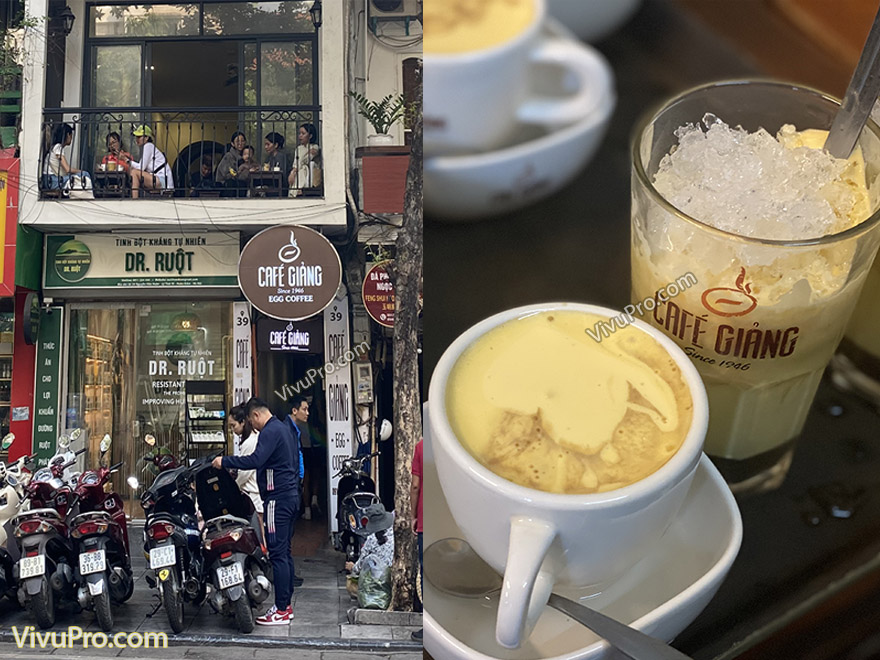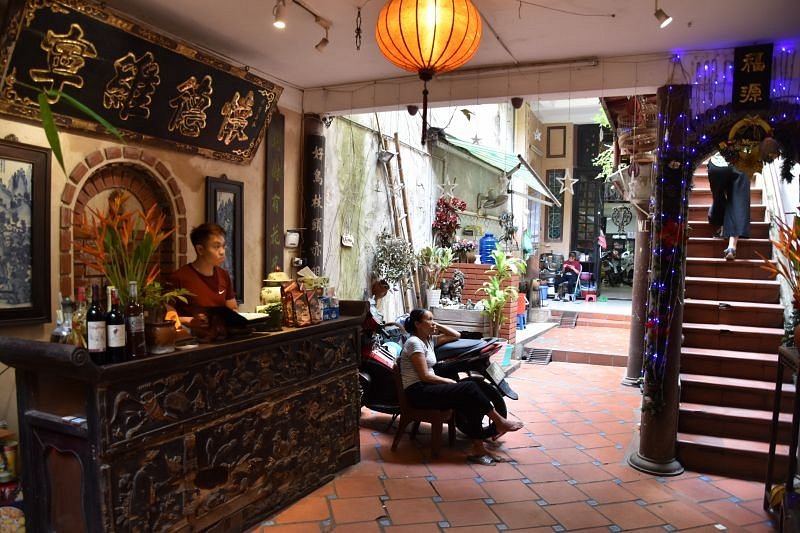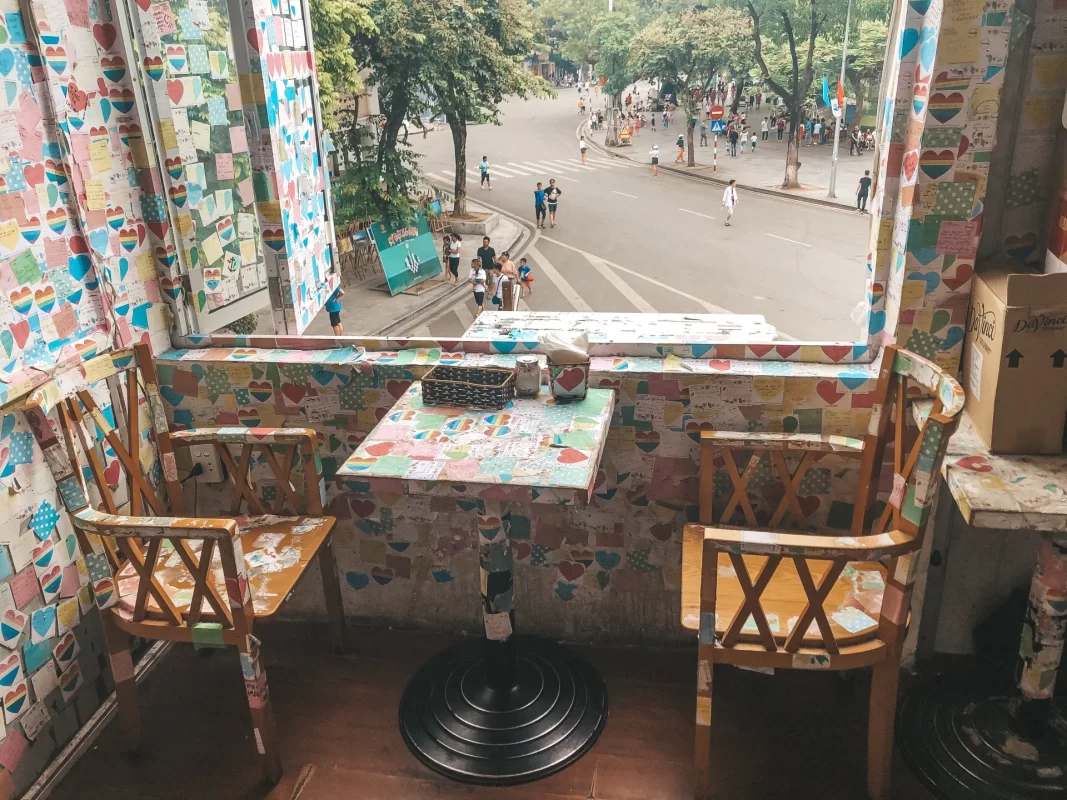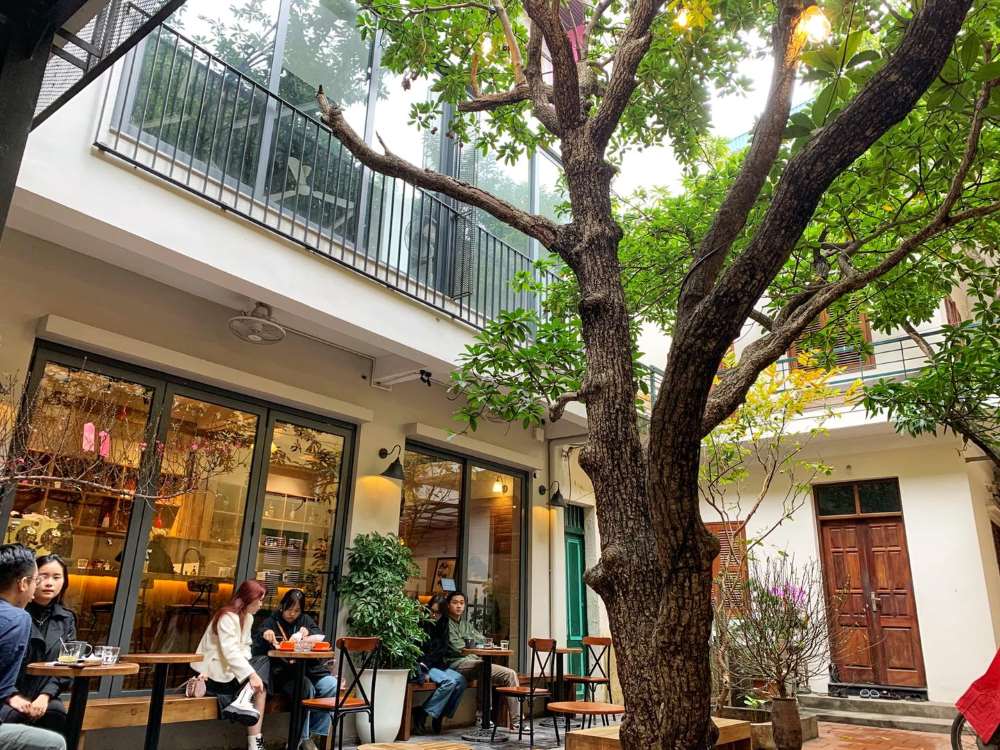Introduction to Hanoi Hidden Cafes
Hanoi, Vietnam’s vibrant capital, is renowned for its bustling streets, historic landmarks, and a coffee culture that pulses through its veins. Among its many treasures, Hanoi hidden cafes stand out as intimate sanctuaries tucked away in narrow alleys, crumbling colonial villas, and unassuming shopfronts. These secret coffee spots, often concealed behind unmarked doors or up rickety staircases, offer more than just a cup of ca phe—they provide a glimpse into Hanoi’s soul, blending history, creativity, and community. From the iconic egg coffee born during wartime scarcity to modern blends served in quirky, Instagram-worthy nooks, Hanoi’s hidden cafes are a cultural “show” that captivates locals and travelers alike. This article explores the history, allure, and unique stories of Hanoi hidden cafes, compares them with other hidden coffee spots across Vietnam, and highlights the authentic culinary experiences at VietRice Essence Restaurant and Viet Rice Kitchen Cooking Class, which complement Hanoi’s coffee culture with traditional Vietnamese flavors.
Historical Roots of Hanoi Hidden Cafes
Origins of Hanoi’s Coffee Culture
Hanoi’s coffee culture traces its roots to the French colonial period (1887–1945), when coffee was introduced to Vietnam in 1857 as a cash crop. The French brought their cafe traditions, establishing open-air coffee stalls and elegant parlors in Hanoi’s Old Quarter. By the early 20th century, coffee had become a social ritual, with locals adapting French techniques to create distinctly Vietnamese brews using the phin, a metal drip filter that produces a strong, slow-brewed coffee.
The Old Quarter, with its maze-like streets, became the epicenter of Hanoi’s coffee scene. Narrow shophouses, known as “tube houses,” doubled as cafes, their hidden interiors offering respite from the bustling markets. These early cafes, often family-run, laid the groundwork for today’s hidden gems, where secrecy and intimacy are part of the charm.
Wartime Innovation and Egg Coffee
The Vietnam War (1955–1975) and its preceding conflicts shaped Hanoi’s hidden cafes in profound ways. During the French War (1946–1954), milk shortages forced creative solutions. Nguyen Van Giang, a bartender at the Sofitel Legend Metropole Hotel, invented egg coffee (ca phe trung) in the 1940s, whisking egg yolks with sugar and condensed milk to mimic cappuccino’s creamy froth. This decadent drink, born from necessity, became a Hanoi specialty, first served at Giang Cafe, a hidden spot accessed through a narrow alley in the Old Quarter.
Hidden cafes flourished during wartime as discreet gathering places for intellectuals, artists, and revolutionaries. Tucked away in alleys or upper floors, these spots offered safety from surveillance, fostering discussions that fueled Vietnam’s independence movement. The secretive nature of these cafes, born from necessity, became a defining trait, preserved in modern Hanoi’s hidden coffee culture.
Post-War Resurgence
After the Vietnam War, Vietnam’s economy struggled under collectivization, limiting coffee production. The 1986 Đổi Mới reforms, which liberalized the economy, sparked a coffee renaissance. Hanoi’s hidden cafes multiplied, with entrepreneurs transforming colonial villas, attic spaces, and courtyard homes into quirky coffeehouses. The rise of Robusta beans, which account for 97% of Vietnam’s coffee production, fueled the boom, offering a bold, bitter flavor that locals love. Today, Vietnam is the world’s second-largest coffee producer, behind Brazil, and Hanoi’s hidden cafes are a testament to this legacy.
The “Show” of Hanoi Hidden Cafes
Discovering the Hidden Gems
Hanoi hidden cafes are a sensory adventure, often requiring a bit of detective work to find. Tucked behind souvenir shops, accessed via spiral staircases, or concealed in crumbling French villas, these cafes reward the curious with unique atmospheres and exceptional coffee. The “show” lies in the journey—navigating narrow alleys, ducking under low doorways, and emerging into cozy, eclectic spaces that feel like stepping back in time.
Key examples include:
- Cafe Giang (39 Nguyen Huu Huan): The birthplace of egg coffee, this cafe is hidden down a narrow alley in the Old Quarter. Its tiny stools, retro decor, and creamy ca phe trung create a nostalgic vibe, drawing locals and tourists alike.

- Cafe Pho Co (11 Hang Gai): Accessed through a souvenir shop and up a spiral staircase, this cafe offers stunning views of Hoan Kiem Lake. Its lush courtyard and egg coffee make it a serene escape from the Old Quarter’s chaos.

- The Note Coffee (1 Hang Mam): A “post office” of emotions, this hidden gem is covered in colorful sticky notes where visitors leave messages. Its cozy interior and salt coffee (ca phe muoi) offer a quirky, intimate experience.

- Tranquil Books & Coffee (5 Nguyen Quang Bich): Tucked in a quiet alley, this cafe doubles as a bookstore, with low tables and a shoe-free upstairs requiring floor seating. Its dim lighting and mango smoothies create a cozy, work-friendly haven.

Ambiance and Creativity
The allure of Hanoi hidden cafes lies in their eclectic ambiance. Many occupy renovated colonial buildings, with peeling paint, vintage furniture, and black-and-white photos evoking Hanoi’s past. Others, like Manzi Art Space & Cafe, blend coffee with contemporary art, hosting exhibitions and workshops in a 1930s French villa. The Note Coffee’s sticky-note-covered walls and Pho Co’s plant-filled courtyard add playful, Instagram-worthy touches, while Cong Caphe’s Viet Cong-inspired decor—complete with army-green interiors and retro posters—offers a nod to Vietnam’s revolutionary history.
The coffee itself is a performance. Baristas use the phin to brew Robusta-heavy blends, often mixed with condensed milk (ca phe sua da) or egg foam (ca phe trung). Specialty drinks like coconut coffee (ca phe dua) and salt coffee, pioneered in Hue but popular in Hanoi, add tropical or savory twists. The slow drip of the phin, paired with the chatter of locals and hum of motorbikes outside, creates a meditative ritual that defines Hanoi’s coffee culture.
Community and Culture
Hidden cafes are social hubs where Hanoi’s past and present converge. Locals gather on low stools, sipping ca phe den (black coffee) and sharing ba tam (gossip), a tradition rooted in Vietnam’s communal lifestyle. Artists, students, and expats frequent these spots for their quiet corners and fast Wi-Fi, making them ideal for work or reflection. The secrecy of these cafes fosters intimacy, encouraging conversations that feel personal and unhurried, a stark contrast to Hanoi’s frenetic streets.
History Behind Hanoi Hidden Cafes
Colonial and Wartime Influences
The hidden nature of Hanoi’s cafes is a legacy of its colonial and wartime history. During French rule, cafes were public spaces for the elite, but Vietnamese locals carved out discreet corners for their own gatherings. The Old Quarter’s tube houses, with their deep, narrow interiors, provided natural hiding spots, a trait that persisted through the Vietnam War when cafes served as safe havens for dissenters.
Egg coffee’s invention at Giang Cafe is a prime example of wartime ingenuity. With milk scarce, Nguyen Van Giang’s use of egg yolks not only solved a practical problem but also created a cultural icon. Similarly, the use of Robusta beans, which are hardier and higher in caffeine than Arabica, reflects Vietnam’s agricultural adaptation to its climate and economic needs.
Post-Reform Creativity
The Đổi Mới reforms of 1986 unleashed a wave of entrepreneurial spirit, transforming Hanoi’s hidden cafes into creative outlets. Owners began repurposing old spaces—attics, courtyards, and villas—into cafes that blended nostalgia with modernity. The rise of social media in the 2010s amplified their appeal, with Instagram posts of egg coffee and quirky decor drawing global travelers. Today, Hanoi’s hidden cafes are a microcosm of the city’s evolution, balancing tradition with innovation.
Comparing Hanoi Hidden Cafes with Other Hidden Coffee Spots in Vietnam
Hoi An Hidden Cafes
Hoi An, a UNESCO World Heritage Site in central Vietnam, is known for its lantern-lit Ancient Town and serene cafes, many of which are hidden gems. Unlike Hanoi’s urban, history-heavy cafes, Hoi An’s hidden spots emphasize tranquility and natural beauty, often set against rice paddies or rivers.
- Reaching Out Teahouse (Tran Phu Street): This silent cafe, where staff communicate via order sheets, is tucked in the Ancient Town. Its focus on tea and coffee, enjoyed in silence, contrasts with Hanoi’s chatty, communal vibe.
- Fika Cafe (Old Town): Hidden down a quiet alley, Fika offers salted iced lattes and rice paddy views, rewarding eco-conscious visitors with discounts for biking. Its relaxed, rural setting differs from Hanoi’s gritty, urban charm.
- Roving Chill House (Cam Son): Located in Hoi An’s countryside, this cafe’s outdoor swings and paddy views create a laid-back atmosphere, unlike Hanoi’s tucked-away, colonial-inspired spaces.
Hoi An’s cafes are prettier and slower-paced, reflecting the town’s leisurely lifestyle. Hanoi’s hidden cafes, however, are more eclectic, with a stronger historical narrative tied to wartime and colonial legacies. Hoi An lacks Hanoi’s unique drinks like egg coffee, but its salted lattes and coconut coffee are gaining fame.
Ho Chi Minh City (Saigon) Hidden Cafes
Ho Chi Minh City, Vietnam’s economic hub, boasts a modern, Instagram-driven coffee scene with hidden cafes that rival Hanoi’s in creativity but differ in vibe. Saigon’s cafes are often sleek and trendy, reflecting the city’s cosmopolitan energy.
- Ca Phe Do Phu (District 1): Hidden behind a vintage Citroen, this cafe was once a Viet Cong supporter’s home, with secret tunnels from the Vietnam War. Its historical significance parallels Hanoi’s wartime cafes, but its polished decor feels more contemporary.
- Apartment Block Cafes (District 3): These multi-story buildings house dozens of micro-cafes, each with unique themes, from retro to minimalist. Unlike Hanoi’s single, tucked-away spots, Saigon’s apartment cafes offer variety in one location, catering to digital nomads.
Saigon’s hidden cafes prioritize aesthetics and modern blends, lacking Hanoi’s deep historical roots. While Hanoi’s egg coffee and phin-brewed Robusta dominate, Saigon excels in Western-style lattes and air-conditioned comfort, appealing to a younger, global crowd.
Hue Hidden Cafes
Hue, the former imperial capital, has a quieter coffee scene, with hidden cafes that blend imperial elegance with modern twists.
- Salt Coffee Stalls: Hue pioneered salt coffee (ca phe muoi), a savory blend with a pinch of salt to balance bitterness. Small, family-run stalls in alleys off Le Loi Street serve this drink, offering a cozy, local vibe similar to Hanoi’s hidden cafes but with less historical weight.
- Garden Cafes (Kim Long): Tucked in Hue’s imperial gardens, these cafes offer serene settings with lotus ponds, contrasting Hanoi’s urban grit. They focus on tea and light coffee, lacking the bold Robusta blends of Hanoi.
Hue’s hidden cafes are intimate but less quirky than Hanoi’s, with a focus on central Vietnamese flavors. Hanoi’s cafes, with their wartime stories and colonial architecture, offer a richer historical narrative and more diverse drinks like egg and coconut coffee.
Comparative Summary
Hanoi hidden cafes stand out for their historical depth, tied to wartime innovation and colonial legacies. Hoi An’s cafes prioritize beauty and tranquility, Saigon’s lean toward modern aesthetics, and Hue’s emphasize local flavors like salt coffee. Hanoi’s egg coffee, born in hidden alleys, gives it a unique edge, while its gritty, eclectic spaces contrast with the polished or serene vibes elsewhere. All share a love for Robusta and the phin, but Hanoi’s cafes are unmatched in their storytelling and secretive charm.
Culinary Connection to Hanoi Hidden Cafes
Coffee and Cuisine in Hanoi
Hanoi’s hidden cafes are inseparable from its food culture, where coffee pairs with street food staples like pho, bun cha, and banh mi. Many cafes, like The Note Coffee, serve light bites such as banh mi or smoothies, creating a holistic culinary experience. The Old Quarter’s proximity to Dong Xuan Market and street vendors means visitors can pair a cup of egg coffee with a bowl of pho or a crispy banh xeo, immersing themselves in Hanoi’s flavors.
The slow, communal nature of coffee drinking in hidden cafes mirrors Vietnam’s dining culture, where meals are shared and savored. The phin’s deliberate drip echoes the patience required to enjoy Hanoi’s cuisine, from simmering broths to hand-rolled spring rolls, tying coffee to the city’s culinary heritage.
VietRice Essence Restaurant: A Taste of Hanoi’s Heart
For those seeking to complement Hanoi’s hidden cafe experience with authentic cuisine, VietRice Essence Restaurant is a must-visit. Located at 93 Phung Hung, Hoan Kiem District, just steps from the Old Quarter, this cozy eatery serves northern Vietnamese dishes like bun cha, lotus stem salad, and beef in bamboo, capturing the bold, fresh flavors of Hanoi’s street food. The restaurant’s menu, praised for its exquisite textures and quality, reflects the same care and tradition found in hidden cafes, where every cup tells a story.
VietRice Essence’s warm ambiance, with attentive staff like Nam and Ms. Nhan, evokes the intimacy of a hidden cafe, making it an ideal stop after sipping egg coffee at Giang Cafe or The Note. Diners rave about the vegetarian options and complimentary drinks, which add a thoughtful touch, much like the personal service in Hanoi’s secret coffee spots.
Viet Rice Kitchen Cooking Class: Crafting Hanoi’s Flavors
To dive deeper into Hanoi’s culinary culture, Viet Rice Kitchen Cooking Class offers an immersive experience that pairs perfectly with the city’s hidden cafe scene. Held daily from 9:00 AM to 11:00 AM or 2:00 PM to 4:00 PM, these two-hour classes begin with a guided tour of Dong Xuan Market, where participants select fresh ingredients like herbs, rice noodles, and fish sauce, mirroring the vibrant markets near Hanoi’s cafes.
Led by a 5-star professional chef, the classes teach dishes like spring rolls, herb-infused chicken, and lotus stem salad, which share the light, aromatic profile of Hanoi’s cuisine. Participants enjoy their creations in a traditional setting, with a complimentary drink and a video memento, plus recipes to recreate dishes at home. This hands-on journey, blending market exploration with cooking, echoes the discovery of hidden cafes, where finding the spot is part of the adventure. Viet Rice Kitchen’s focus on authentic recipes connects travelers to Hanoi’s culinary heritage, enhancing the coffee culture experience.
Cultural and Tourism Impact
Preservation and Challenges
Hanoi hidden cafes are cultural treasures, preserving the city’s history and social traditions. However, rapid tourism growth and urbanization threaten their authenticity. Overcrowding in the Old Quarter, as noted in Reddit discussions, can disrupt the intimate vibe of cafes like Cafe Pho Co, while rising rents push owners to modernize or relocate. Initiatives like the Hanoi Old Quarter Management Board promote sustainable tourism, encouraging preservation of colonial buildings and traditional brewing methods.
VietRice Essence and Viet Rice Kitchen contribute to cultural preservation by showcasing Hanoi’s cuisine authentically. Their market tours and cooking classes educate visitors about local ingredients and traditions, fostering respect for the city’s heritage, much like the storytelling in hidden cafes.
Global Appeal
Hanoi hidden cafes attract millions annually, fueled by social media and travel blogs like Will Fly for Food and Jou Jou Travels. Their quirky decor, historic charm, and unique drinks like egg coffee make them Instagram staples, drawing coffee lovers and solo travelers seeking authentic experiences. The Old Quarter’s proximity to landmarks like Hoan Kiem Lake and Hoa Lo Prison enhances their appeal, making them a gateway to Hanoi’s culture.
Practical Tips for Exploring Hanoi Hidden Cafes
- Timing: Visit early morning (7–9 AM) for a quieter experience or evenings for vibrant night markets. Weekdays avoid tourist crowds.
- Getting There: Most hidden cafes are in the Old Quarter, walkable or reachable by cyclo or Grab from Hanoi’s Noi Bai Airport (45-minute drive). Use Google Maps for alley entrances (e.g., Cafe Giang at 39 Nguyen Huu Huan).
- Must-Try Drinks: Order egg coffee at Giang Cafe or Cafe Pho Co, salt coffee at The Note, or coconut coffee at Cong Caphe. Pair with a banh mi or smoothie.
- Culinary Preparation: Dine at VietRice Essence Restaurant to savor Hanoi dishes like bun cha, complementing the coffee experience. Join a Viet Rice Kitchen Cooking Class to learn recipes that deepen your connection to Hanoi’s flavors, enhancing cafe visits.
- Respectful Tourism: Respect cafe etiquette—keep voices low, avoid flash photography, and tip baristas. Support local vendors for souvenirs like coffee beans or phin filters.
VietRice Essence Restaurant & Viet Rice Kitchen Cooking Class
Your gateway to authentic Vietnamese culinary traditions
https://vietriceessence.com/
http://vietricekitchen.com/

